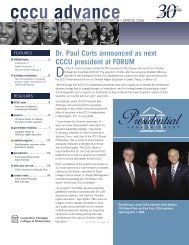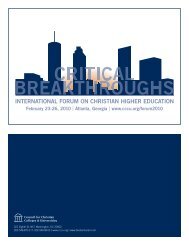Psychoanalysis, Attachment, and Spirituality Part II ... - Dr. Todd Hall
Psychoanalysis, Attachment, and Spirituality Part II ... - Dr. Todd Hall
Psychoanalysis, Attachment, and Spirituality Part II ... - Dr. Todd Hall
You also want an ePaper? Increase the reach of your titles
YUMPU automatically turns print PDFs into web optimized ePapers that Google loves.
40 PSYCHOANALYSIS, ATTACHMENT, AND SPIRITUALITY PART <strong>II</strong><br />
it knowledge about our sense of self each refer to the<br />
other, is critical for both client <strong>and</strong> therapist in revising<br />
the spiritual stories by which our clients live. For<br />
the client, this is the process that undergirds the transformation<br />
of their implicit sense of themselves in relation<br />
to God, as well as others. A safe haven in the therapeutic<br />
relationship provides the relational<br />
environment for clients to capture their gut level sense<br />
of “how to be with” God <strong>and</strong> others in a more explicit<br />
dimension. The very act of making implicit relational<br />
knowledge explicit—of telling their story in<br />
words—transforms it. Furthermore, this linkage<br />
between the implicit <strong>and</strong> explicit facilitates a more full<br />
<strong>and</strong> coherent communication, <strong>and</strong> more secure<br />
between-the-lines story in the therapeutic relationship.<br />
This produces what Siegel (1999) refers to as “contingent<br />
communication” in which clients “feel felt” or<br />
seen by the therapist. This is a form of communication<br />
in which there is a resonance that “means more<br />
than we can say” to use Bruner’s (1990) terminology.<br />
For the therapist, fostering such contingent communication<br />
with our clients is also the result of this<br />
knowledge spiral involved in the referential process.<br />
It is the process by which the therapist tunes into her<br />
implicit sense of the client’s experience, including<br />
spiritual experience, <strong>and</strong> translates this into words,<br />
images <strong>and</strong> metaphors for the client. It is also the process<br />
by which the therapist translates a sense of what<br />
the client needs at any given moment into emotional<br />
<strong>and</strong> verbal communication. Contingent communication<br />
promotes what Fonagy et al. (1995) have called<br />
“reflective self-functioning” in clients. This derives<br />
from William James’ (1890) usage of the term “reflective”<br />
to describe the developmental achievement in<br />
which the mental state of an individual becomes a<br />
subject of thought. In other words, the individual is<br />
able to observe <strong>and</strong> reflect on her own <strong>and</strong> others’<br />
mental states about attachment-related issues.<br />
Reflective self-functioning seems to explain part of<br />
how attachment security is passed down intergenerationally.<br />
Fonagy <strong>and</strong> his colleagues (1995) found evidence<br />
that it buffers the negative effects of deprivation<br />
<strong>and</strong> high stress among mothers on the<br />
attachment security of their children. It thus seems to<br />
reduce the likelihood of insecure attachment being<br />
passed down intergenerationally. Moreover, there<br />
appears to be a reciprocal relationship here—secure<br />
attachment seems to be an important precursor to the<br />
development of reflective self-functioning in children.<br />
A “secure base” in the attachment relationship allows<br />
the child to explore the minds of her caregivers, which<br />
facilitates the development of an appreciation of mental<br />
states. There are clear parallels in the context of the<br />
therapeutic relationship. As therapists provide a<br />
secure attachment relationship, this fosters the development<br />
of reflective self-functioning in their clients.<br />
This in turn helps them appreciate <strong>and</strong> process their<br />
own <strong>and</strong> others’ experiences.<br />
Reflective self-functioning bears resemblance to<br />
James Fowler’s fourth stage of faith development<br />
(Individuative-Reflective), in which one becomes<br />
aware that one has a worldview, <strong>and</strong> is able to step<br />
outside of it <strong>and</strong> interact with it (Fowler, 1981). Similarly,<br />
reflective self-functioning allows an individual<br />
to recognize that he <strong>and</strong> others have mental states<br />
that are not identical to “the way things are.” It is a<br />
form of epistemological humility in the realm of<br />
interpersonal relationships. Reflective self-functioning<br />
allows me to take my mental states about attachment<br />
as objects of scrutiny to be processed, analyzed,<br />
constructed, <strong>and</strong> reconstructed. It puts a<br />
wedge, as it were, between my subjective experience<br />
of myself <strong>and</strong> my mental states.<br />
This reflective capacity requires a secure attachment<br />
relationship to be fully developed, <strong>and</strong> has<br />
enormous implications for relational <strong>and</strong> spiritual<br />
development. In the context of spirituality, this fosters<br />
what we might think of as “reflective spiritual<br />
functioning.” Lacking this reflective capacity will<br />
make it difficult for clients to take their subjective<br />
experiences of God as an object of scrutiny in order<br />
to process them. In other words, it will make it difficult<br />
to tell <strong>and</strong> enact new stories about their spirituality.<br />
Helping our clients become secure enough to<br />
appreciate all their “spiritual” experiences (which<br />
could be viewed as all encompassing, but certainly<br />
including their direct experiences of God through<br />
Scripture, prayer, etc) as something they have; something<br />
they can hold in order to process, analyze, construct,<br />
<strong>and</strong> reconstruct, may be one of the most<br />
important things we can do to mind our clients’ spirituality—both<br />
in the sense of attending to moments<br />
of transition between different levels of experience,<br />
<strong>and</strong> of cultivating it (Sorenson, 2004). R<strong>and</strong>y (Sorenson,<br />
2004) encouraged us to “. . . take an interest in<br />
our patients’ spirituality that is respectful but not diffident,<br />
curious but not reductionistic, welcoming but<br />
not indoctrinating” (p. 1). As we heed his words, we<br />
will model for our clients a way they can begin to<br />
approach their own spirituality, thereby creating new<br />
spiritual stories to live by.












![Download Guide [PDF] - Council for Christian Colleges & Universities](https://img.yumpu.com/37211849/1/190x245/download-guide-pdf-council-for-christian-colleges-universities.jpg?quality=85)



